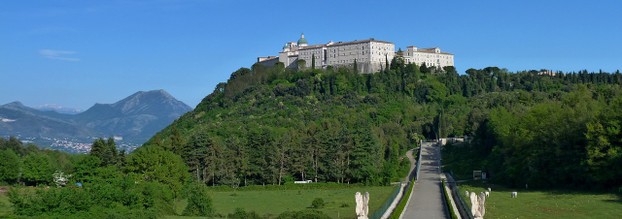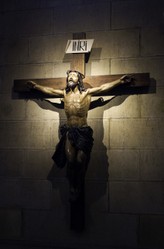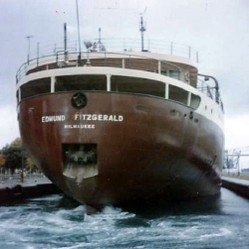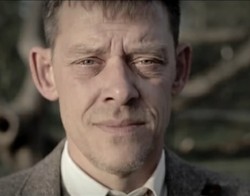In 529 AD St Benedict of Nursia came to settle on the site, founded a monastery and there wrote the rule of St Benedict, which became the basis of Western monasticism. There the Benedictine monks established what may have been Europe's first hospital. But the monastery did not last long after Benedict's death,for it was sacked by invading Lombards, a German tribe, and abandoned for a century. .
The new abbey on the site lasted until the ninth century when it was burned down by invading Saracens, members of an expansionist Muslim tribe who managed to hold Sicily and parts of southern Italy.The abbey was then rebuilt under Abbot Desiderius, and despite damage in an earthquake in 1349 managed to survive until the twentieth century. During this time it was pillaged by Napoleon's troops,but the structure of the building was left intact. In the time of Italian unification when the monasteries were suppressed it became the property of the Italian state, was classed as a national monument but the monks left in charge. [Source, Catholic Herald, Allan Mallinson, May 17th 2019.]
The German occupation was extremely disciplined and civilised. Field Martial Kesselring had left Monte Cassino out of the Gustav line fortifications as it was a cultural treasure, and through the Red Cross informed the allies of his decision, but there were German positions on the hill around the monastery. In November 1943 Lieutenant-Colonel von Schlegel, a Catholic, and medical officer Maximilian Becker, a Protestant, foresaw danger and with the consent of General Von Senger made arrangements to move cultural artefacts, many of which belonged to the monastery and others to a museum. These cultural items were stored at the Vatican. Von Senger personally provided a German army staff car to take away the abbot, who had remained to supervise the removal, and took him to his chosen place of safety, another monastery in a safer area.
The Germans eventually,fearing that they were in danger of being surrounded, retreated across the hills to the Hitler Line, leaving mainly troops too badly wounded to move and a skeleton unit to cover the retreat. On the early morning of the 18th May 1944 a Polish patrol took the monastery with light casualties, and hoisted the Polish flag, the White Eagle of Poland. The monastery remained ruined until after the war.
The dead and wounded numbered 55000 Allied troops and 20000 Germans. The battle was a costly victory.










 Pilgrimage. A reviewon 06/15/2025
Pilgrimage. A reviewon 06/15/2025
 Leo the Fourteenthon 05/09/2025
Leo the Fourteenthon 05/09/2025
 The Melsonby Hoardon 03/25/2025
The Melsonby Hoardon 03/25/2025



Comments
It was all sad. My father hated the war and was glad to get out of it.
Thank you for your comment below, in answer to my previous observation and question.
The third paragraph to the first subheading, The young trooper, advises us that "But one incident had a lasting effect. Early in the siege the Allies became convinced that the Germans were sheltering in the monastery rather than just camped and dug in around the wall, so General Alexander took the hardest decision of his life:to call in the bombers, so in the early light of a February morning in 1944 the United States Air Force launched its awesome power. Hundreds of tons of high explosive hit the monastery, which fortunately had been emptied of monks, but sadly not of refugees, pounding it to rubble and killing two hundred innocents. The bombing made the situation worse, as the surviving Germans were able to fortify the rubble and did so with Germanic efficiency."
It's quite sad that the bombing is not interpreted, then or since or now, as a success, particularly since it terminally imperiled 200 innocents, isn't it?
I am unsure. Most people were known by someone, but not necessarily all.
Thank you for your comment on Jan. 26, 2024, in answer to my previous, same-day observation and question.
Was all identity lost with the bombing or were identities reconstructible for the 200 innocents?
Alerting the refugees would have meant alerting the Germans.
The third parragraph to the first subheading, The young trooper, alerts us that "But one incident had a lasting effect. Early in the siege the Allies became convinced that the Germans were sheltering in the monastery rather than just camped and dug in around the wall, so General Alexander took the hardest decision of his life:to call in the bombers, so in the early light of a February morning in 1944 the United States Air Force launched its awesome power. Hundreds of tons of high explosive hit the monastery, which fortunately had been emptied of monks, but sadly not of refugees, pounding it to rubble and killing two hundred innocents. The bombing made the situation worse, as the surviving Germans were able to fortify the rubble and did so with Germanic efficiency."
Is it known why refugees were not relocated in advance of the attack?
Thank you, Frank, for your explanation. Thank you for your note on the word trooper as well. Speaking of which, you mentioned how your father didn't want to remember the war. Same with one of my grandfathers, who was old enough to fight in WWII. He said he dreamed about battlefields and shells exploding quite often, and he wasn't even a trooper or in the infantry. He was some kind of ajutant.
I am in full agreement with you about the importance of the EU and the wrongness of Brexit. I have written before that Brexit is a right wing attempt to get rid of the workers' rights promoted by the EU. Right wingers have misled the element in the British populace who think that we are still powerful, and they have sold monstrous lies to the British working class, blaming the EU for the problems that were caused by our own government.
Why no second referendum? Easy, the hard right wing suspect that they would lose it, and the ruling party in the UK is dominated by them.
By the way, note that I described my father as a trooper. Trooper is a term for an ordinary soldier in one of the old cavalry regiments, though he was in an armoured car .
This is a very moving piece! Europe has gone through so much through the centuries, which is all the more reason to celebrate the European Union today. It's a large body and the challenges are many, but it has accomplished so much since its inception. I am so sorry about Brexit, but heartened to see that there are so many who'd want a second referendum. I can't understand why they are not doing this second referendum.
Andrew [my son] told me that it was the anniversary, and so in memory of Dad and all who were present at the battle I knew that something had to be written. I have reported all that he said about the battle and so have no more to tell.
You were not present in the room when Dad had to walk out [only Dad, Barney and I were there] otherwise I would have mentioned you.